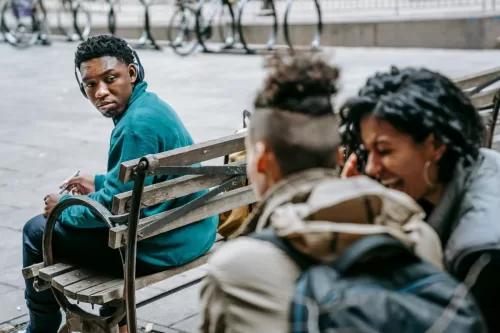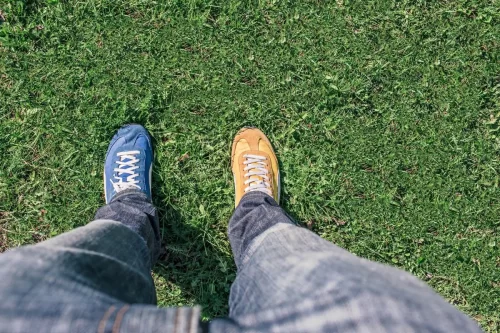Defining Autism Spectrum Disorder: What Does It Feel Like?

I am often asked what does it mean to be on the autism spectrum, and I’ll admit it is a challenging question to answer. Explaining autism and what autistic people experience in everyday day life and how they can overcome their challenges is highly individualized.
However, I will attempt to define the autism spectrum from my own personal lived experience as a young adult male. While it’s important to note that my experience will be unique from anyone else’s, I hope my answer can provide a better level of understanding and acceptance.
For me, the world can often feel like an intensely overwhelming place. I know my brain processes and experiences reality in profoundly different ways compared to the non-autistic majority. When I attempt to define the autism spectrum, I describe that the autistic experience is multi-layered, highly complex, and deeply enriching – but it also comes with a unique set of challenges in navigating a life that is designed for neurotypical sensory, social, and cognitive experiences.
Or, more simply put, sometimes I feel like I live in a complex alternate reality, and I must face various cumbersome challenges and daily tasks to try and manage the life that everyone else seems to do so effortlessly. Then, I go to bed, the “game of life” resets, and then the challenges begin all over again.
While autism manifests across a broad spectrum with varying traits from one individual to the next, some common threads create a shared understanding of the autistic lived experience. By opening a window into my inner world, I hope to foster greater awareness, empathy, and inclusion for autistic people in all areas of life.
READ MORE: Think You Know Neurodivergence? Debunking These Popular Myths About Autism
Defining Autism Spectrum Disorder and Sensory Intensity
For many autistic individuals, one of the most overwhelming aspects is sensory processing differences related to the five senses – sight, sound, smell, taste, and touch. Autistic brains have diverse wiring that can make us hyper or hypo-sensitive to sensory input that neurotypicals may not even consciously register.
Sounds that others tune out like humming fluorescent lights, nearby conversations, or ambient noises can feel deafening and inescapable for autistic people.
Strong scents like perfumes, cleaners, or cooking spices may be physically painful to smell. Bright lights or strobing effects can cause physical distress or even induce seizures for some. Certain food textures may trigger a gag reflex, while clothing textures like scratchy fabrics or tight waistbands bring intense discomfort.
My sensitivities have evolved since childhood, although I acknowledge they are still there. As a child, I was sensitive to loud noises and would sometimes wear headphones to tune out noises such as shrieks of students in the hallways during class changes, at big events like Monster Truck Rallies (I had a love-hate relationship with attending them), and the shrill of phones and other technology.
Today, my sensitivities are different, although still present. For example, I cannot stand commercials that come on when watching television, and always immediately try and mute them. They seem to be louder than the show I am watching and are highly annoying. Also, my family’s dogs constantly pitter-patter on our hardwood floors, and the sound is enormously grating.
While being hypersensitive is still one of the ways I define the autism spectrum, I am becoming more comfortable with sensory issues as I get older.
While some sensory input is fragmented and overwhelming, for other senses the autistic experience is almost the opposite – seeking out intense sensory experiences like listening to thunderously loud music, chewing on chewy or crunchy foods obsessively, or rubbing different textures between our fingers. I never thought I had hypo-sensitivity when defining autism spectrum disorder traits I have, but I have come to realize I turn up the volume of music and television when I’m alone.
Self-stimulating repetitive behaviors like rocking, flapping hands, chewing, or making humming sounds often many autistics find balance and comfort amidst the barrage of sensory input. I will rock at times and even roll my eyes at times, which I understand now are kinds of stimming.
READ MORE: On the Autism Spectrum – Top Hurdles Individuals Face Daily
Autism Spectrum Defined: Social Communication Disconnect

Defining autism spectrum disorder for me means that I may sometimes stare off into space, go long periods without speaking, make blunt observations, or miss subtle cues during conversations. I may have delays with processing verbal information and need more time for it to compute before responding.
It’s always irritating when I’m processing that people push me for an immediate response. I understand the traits I’ve mentioned are very common with others as well and may be helpful when explaining autism to others.
Autistic communication styles may be very direct and literal, and I have at times been accused of being “rude.” Eye contact is frequently uncomfortable for some, although I manage this aspect pretty well. Autistics can struggle with emotional reciprocity – understanding and expressing emotions in expected ways. Basic small talk is sometimes confounding and overwhelming. For me, small talk is possible, but it is mentally draining. I feel like a simple conversation can zap my energy, and I need time to recover from it.
Social masking – attempting to study, mimic, and perform expected neurotypical social behaviors – is a common coping mechanism deployed by many autistics from an early age in hopes of fitting in. Research says social masking is more common in females with autism than in males. This emotional labor can lead to increased autistic burnout, social withdrawal, meltdowns, and even medical issues over time.
READ MORE: Autism Masking & Code Switching – How to Redefine Acceptance
Explaining Autism and Its Intense Interests and Sensory Connections
While communication and certain sensory experiences can be challenging for many autistics, on the other side of the spectrum, individuals often experience profoundly rich realms of intensity, focus, and depth. Many of us in the community develop specialized “special interests” that provide us with immense joy, motivation, and purpose.
These interests may strike neurotypicals as overly narrow obsessions – perhaps dinosaurs, quantum physics, mythology, gaming, or international geography as examples. For autistic people, these topics are lenses for understanding the world more deeply, forming meaningful connections, and creating safe, soothing, and cathartic spaces away from social overwhelm.
Our ability to hyper-focus and develop sometimes encyclopedic knowledge allows us to make unique contributions to these specialized fields of study. One of my obsessions is simply absorbing knowledge, and I spend hours devouring websites and videos about history, scientific discoveries, and topics like artificial intelligence.
There is also an intimacy and intensity with which many autistic individuals experience the physical world through their senses. We may find beauty and comfort in niche sensory experiences like the warm resonance of a guitar string vibration, the way light filters through a kaleidoscope, or the texture of soft fabrics brushing our skin.
I am tactile personally, both in admiring certain textures as well as having extreme avoidance in others. Wearing comfortable clothing and snuggling up to a soft blanket are examples of things I like, while scratchy fabrics or rough towels are ones I reject.
Autism spectrum defined by renowned autistic author and animal science expert Dr. Temple Grandin states, “My mind is full of machinery, picture galleries, and multimedia shows that are available at any time. I can compare many things side by side in a way a normal person cannot.”
RELATED: Monotropism Theory – How to Navigate Intense Interests
Defining Autism Spectrum Disorder by Identity and Community
For many autistic individuals, connecting with others on the spectrum and embracing autistic identity is an integral part of the experience. Online communities (and I consider my blog as an example, have provided a powerful platform for autistic self-advocates to share stories, insights, accomplishments, and struggles in their voices without filter.
Autistic pride movements, affirmation of identity-first language based on individual preferences (i.e.”autistic person” vs “person with autism”), and increased representation in media have all helped shape a more self-determined autistic narrative. This pushes back against the history of autism being portrayed solely through a neurotypical, medicalized lens obsessed with curing perceived “deficits.”
Autistic people are increasingly proud to claim their neurological identities and view autism not as a tragedy or puzzle to be solved, but as an inseparable part of their overall personhood – one that comes with both intense challenges and brilliant strengths. Autistic characters in shows like The A Word, Atypical, Everything’s Gonna Be Okay, The Good Doctor, and Please Stand By have resonated deeply with many in sharing authentic portrayals of autistic experiences.
Joyful stimming, deep special interests, and sensory experiences are valid and celebrated parts of being autistic. Neurodiverse relationships, both romantic and platonic, have become more visible, showcasing how similarities can create strong bonds. Online and in-person support spaces have created incredible communities where autistic people reach outside of their comfort zone and no longer feel alone or forced to mask their authentic selves.
RELATED: Shedding Light on Autism and Why It’s An Invisible Disability
Autism Spectrum Defined: Employment, Independence, and Self-Advocacy
As the saying goes, “If you’ve met one autistic person, you’ve met one autistic person.” The tremendous diversity across the spectrum means some autistic individuals may be non-speaking or severely impacted by co-occurring conditions. Others, can mask more effectively and blend into neurotypical spaces – though that ability to conform often comes at a heavy psychological and physical toll.
As an individual who was diagnosed with Asperger’s syndrome—the same year that it stopped being a separate condition and was rolled over to the broader umbrella term of autism—the labels of “high functioning” or “low support needs,” etc., can be confusing and pathologizing to individuals. After all, everyone has their strengths and challenges, and don’t need limiting names to determine who and what we are. I am just me. That should be enough.

Communication supports like text-to-speech apps, AAC devices, noise-canceling headphones, and visual aids are helping remove accessibility barriers for autistic people to live more independently. I also am excited about the integration of artificial intelligence (AI) as a resource tool for individuals with autism. If you haven’t learned about the ways AI is helping autistics here is more information you find helpful.
On the flip side, autistic self-advocates are demanding more input in shaping the narrative about their own lives, needs, and experiences.
Too often, conversations about autism exclude actual autistic voices and perspectives – even in research, policy-making spaces, educational approaches like ABA therapy that some autistic people consider unethical or at least unhelpful, and access to appropriate mental health and medical care. This systemic exclusion of authentic autistic viewpoints of what does it mean to be on the autism spectrum is something the neurodiversity movement is working hard to rectify.
Autistic people’s intense emotions, sensory encounters, special interest connections, and vivid inner experiences are no less valid than anyone else’s. We simply tune into different wavelengths and interpret reality through a uniquely tinted lens. By embracing that neurodiversity and making accommodations to meet each other halfway, we can create a vastly more vibrant, rich, and multi-hued experience of human existence for all.
RELATED: Thinking Differently – Why Having Brains on Fire Sparks Innovation
Autism Spectrum Defined Through Bridging the Gap
So how can the autistic community convey these intense, complex experiences of sensory overload, communication differences, and deep special interest connections to neurotypical people? How do we educate and create increased mutual understanding across this neurological divide when answering what does autism feel like?
One powerful approach is immersing neurotypicals in simulated sensory experiences or conversational examples that provide a glimpse into our inner worlds. There are online games, videos, and even professional development workshops that recreate sensory overload experiences or attempt to depict the challenges of auditory processing or social scripting an autistic person encounters.

Autistic artists across different mediums like blogs, books, poetry, visual arts, music, and film are increasingly using their work to depict the autistic experience in ways that can profoundly impact how it is perceived and understood. Autistic voices telling authentic stories without the filter or curation of neurotypical perspectives is critical.
Additionally, open and transparent communication about our individual needs, quirks, and experiences by creating receptive spaces can go a long way. Autistic people can voice our preferences like requesting quieter environments, written guidelines for social scenarios, and dismissing shame around stimming or special interest infodumps.
Neurotypicals in our lives can demonstrate willingness to learn when we are explaining autism and make accommodating adjustments where possible without judgment.
Perhaps most importantly, neurotypicals must recognize that autistic individuals have vivid internal experiences and senses of personhood that are every bit as vibrant, joyful, and meaningful as their own. Our intense emotions, sensations, and enriching connections may be channeled through different means, but that doesn’t make them any less valid or human.
When defining autism spectrum disorder, it is critical to understand we are not puzzles or riddles to be solved or behaviors to be corrected – we are different and unique and part of the profound diversity within human existence.
With increased mutual understanding and embracing neurodiversity, autistic people can feel empowered to be true to our authentic selves. We can experience acceptance without facades, and inclusion without assimilation. That is one of the many reasons why I created My Autism Mind, and hope to connect with others both on and off the spectrum, so we can all live our best lives!
READ MORE: Help Achieve Autism Acceptance Through Positive Engagement
Additional FAQs About Autism Spectrum Disorder
- What Are 25 Common Traits of Autism Spectrum Disorder?
- What Are The Top 25 Adult Autism Spectrum Disorder Symptoms?
- Do You Know Your Flavor of Autism Spectrum Disorders?
- Hope for the Future: Will It Transform the Autism World?
- Am I Neurodivergent? Understanding Neurodiversity and Its Value is Key
- Autism Questions: 6 FAQs You Really Want to Know
- Is Autism A Disability? Surprising Reasons for the Debate
- Alexithymia Symptoms: Is Emotional Blindness A Thing?
- Is The Absurd Plot Connecting Autism and Evolution Harmful?